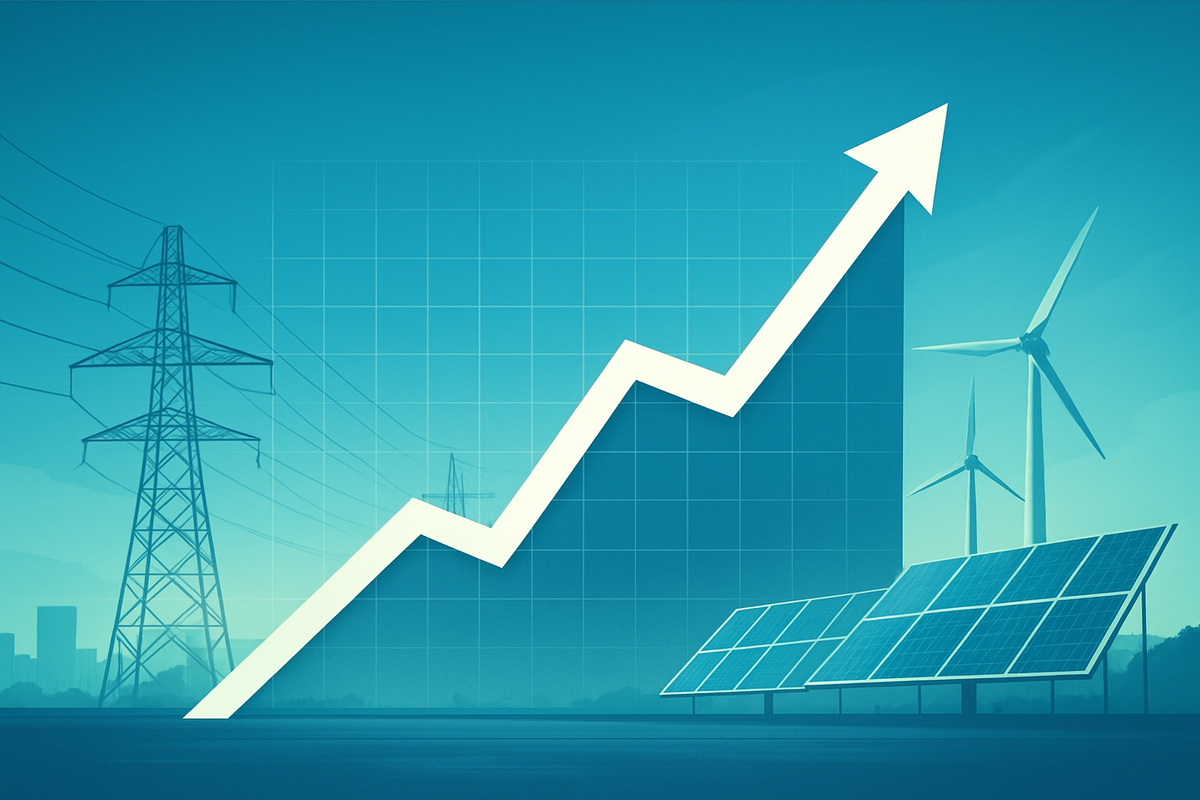
Public Service Enterprise Group Inc (NYSE: PEG) has reported a robust third quarter for 2025, significantly exceeding analyst expectations with strong financial results and reaffirming its aggressive strategic investment in infrastructure modernization and decarbonization. These impressive outcomes not only underscore the company's resilient operational framework but also signal a positive trajectory for the broader utility sector, particularly for entities committed to sustainable growth and technological advancement. The company's performance, announced well ahead of the current date of November 3, 2025, paints a picture of a utility navigating evolving energy demands and climate challenges with strategic foresight.
The strong showing from PSEG, a leading diversified energy company, is poised to instill confidence among investors and stakeholders, highlighting the critical role of regulated utilities in maintaining grid reliability and driving the clean energy transition. The results indicate that strategic capital allocation towards essential infrastructure and clean energy initiatives is not just an environmental imperative but also a sound financial strategy, positioning PSEG as a key player in the dynamic energy landscape.
PSEG's Q3 2025: A Deep Dive into Financial Strength and Future-Proofing Initiatives
Public Service Enterprise Group Inc (NYSE: PEG) delivered a standout performance in the third quarter of 2025, showcasing significant operational and financial achievements that surpassed market forecasts. The company reported a net income of $622 million for Q3 2025, a substantial increase from $520 million in the same period last year. This strong bottom-line growth translated into an impressive Earnings Per Share (EPS) of $1.24, comfortably exceeding analyst estimates that had ranged from $1.00 to $1.03 per share. Furthermore, non-GAAP operating earnings per share reached $1.13, up from $0.90 in Q3 2024, reflecting a healthy 26% increase in non-GAAP operating earnings for the quarter. While revenue reports were mixed, some sources indicated operating revenue of $3.22 billion or $3.23 billion, surpassing expectations and demonstrating a notable year-over-year growth, partly due to new rates from the October 2024 base rate case settlement and higher power pricing.
This strong financial footing is bolstered by Public Service Electric and Gas Company (PSE&G), PSEG's utility arm, which demonstrated remarkable operational resilience by rapidly restoring services after a severe storm in July 2025. This rapid response minimized disruption and highlighted the effectiveness of their infrastructure. The company also completed crucial upgrades at the Hope Creek nuclear facility, a key asset in its carbon-free generation portfolio. A significant development included securing a five-year contract extension to continue as the operations service provider for the Long Island Power Authority through 2030, solidifying its operational footprint.
PSEG's robust capital investment program remains central to its strategy. Approximately $1 billion was invested in regulated capital spending during Q3 2025, bringing the year-to-date total to $2.7 billion. The company is on track with its planned $3.8 billion full-year regulated capital spending for 2025 and reaffirmed its ambitious five-year capital investment program for 2025-2029, ranging from $22.5 billion to $26 billion, with the majority allocated to regulated investments. These funds are earmarked for critical projects such as the extension of the Hope Creek nuclear unit's fuel cycle, the Salem Upgrade Project to add 200 megawatts, a $2.9 billion Infrastructure Advancement Program to future-proof distribution networks, and new energy efficiency programs with an investment of up to $2.9 billion over six years.
Market Implications: Who Wins and Who Adapts in the Evolving Utility Landscape
The stellar Q3 2025 performance by Public Service Enterprise Group Inc (NYSE: PEG) positions the company as a clear winner in the current financial climate. Its strong financial health, coupled with aggressive strategic investments in grid modernization and clean energy, provides a solid foundation for sustained growth and shareholder returns. The ability to fund its multi-billion-dollar capital programs through 2029 without needing to issue new equity or sell assets speaks volumes about its financial prudence and robust balance sheet, making it an attractive prospect for long-term investors.
Beyond PSEG, other utilities that have proactively embraced infrastructure upgrades and a transition to clean energy are also likely to benefit from this trend. Companies investing in smart grid technologies, renewable energy integration, and energy efficiency programs are better positioned to meet increasing energy demands, particularly from burgeoning sectors like data centers. Providers of renewable energy solutions, grid technology, and energy efficiency services could also see increased demand for their offerings as utilities nationwide follow similar investment pathways. Conversely, utilities that are slow to adapt to these evolving demands, or those heavily reliant on outdated infrastructure and fossil fuels without a clear transition plan, may find themselves at a disadvantage. They could face increased operational costs, regulatory pressures, and a diminished competitive edge in a market increasingly prioritizing sustainability and resilience.
Wider Significance: Reshaping the Utility Sector's Future
PSEG's Q3 2025 results are more than just a snapshot of one company's success; they are a significant indicator of broader industry trends reshaping the utility sector. The company's resilience in the face of operational challenges, coupled with its ability to exceed financial expectations, underscores the inherent stability and growth potential within regulated utility operations that prioritize modernization. This performance highlights a critical shift where strategic capital investments in grid hardening, energy efficiency, and carbon-free generation are becoming non-negotiable for sustainable growth.
The increasing demand for electricity, notably from the proliferation of data centers in regions like New Jersey, presents a substantial tailwind for utilities like PSEG. This trend suggests a broader opportunity for utilities in areas experiencing an influx of data-intensive industries, compelling them to expand capacity and enhance grid reliability. Furthermore, the positive impact of new rates stemming from the October 2024 base rate case settlement demonstrates how supportive regulatory environments, aligned with state and federal clean energy mandates, can be a powerful catalyst for financial growth and infrastructure development in the sector. PSEG's commitment to achieving 100% carbon-free energy resources by 2030 not only aligns with New Jersey's clean energy goals but also sets a precedent for other utilities striving for decarbonization, potentially creating ripple effects across the industry and driving innovation in renewable energy and storage solutions. Historically, utilities have been seen as stable, dividend-paying investments; however, the current landscape demands agility and foresight to integrate new technologies and meet ambitious environmental targets, redefining what constitutes a successful utility in the 21st century.
The Road Ahead: Navigating Growth and Transformation
Looking ahead, Public Service Enterprise Group Inc (NYSE: PEG) is poised for continued growth, driven by its well-defined strategic roadmap. In the short term, investors can anticipate the company to maintain its strong capital investment pace, particularly in its regulated utility operations. The narrowed 2025 non-GAAP operating earnings guidance to the upper half of the range ($4.00-$4.06 per share) reflects management's confidence in achieving its targets. The focus will remain on the execution of its extensive capital plan, including the Infrastructure Advancement Program and energy efficiency initiatives, which are crucial for meeting growing energy demands and enhancing grid resilience.
In the long term, PSEG's commitment to its five-year capital investment program through 2029 and its reaffirmed long-term non-GAAP operating earnings growth outlook of 5% to 7% compounded annually signals a sustained period of expansion and value creation. The company's strategy of funding these multi-billion-dollar projects without needing to issue new equity or sell assets underscores its financial strength and is expected to support consistent dividend growth, making it an attractive option for income-focused investors. Potential strategic pivots might involve further diversification into advanced energy technologies or partnerships to accelerate its decarbonization goals, especially as the energy transition evolves. Market opportunities will likely emerge in areas such as grid modernization, smart infrastructure, and demand-side management, while challenges will include navigating potential regulatory shifts, managing climate-related operational disruptions, and ensuring energy affordability amidst significant investments.
A Resilient Future: PSEG's Lasting Impact on the Energy Market
Public Service Enterprise Group Inc (NYSE: PEG)'s Q3 2025 earnings call serves as a powerful testament to the company's robust financial health and its strategic foresight in navigating the complex landscape of the modern energy market. The key takeaways from this period include strong earnings growth, effective operational management in the face of environmental challenges, and a steadfast commitment to substantial capital investments in infrastructure modernization and clean energy. PSEG's performance underscores that a proactive approach to grid resilience and decarbonization is not only environmentally responsible but also a significant driver of financial success.
Moving forward, the market will likely view utilities with strong regulated assets and a clear focus on the clean energy transition as prime investment opportunities. PSEG's ability to fund its ambitious capital plan without external equity is a significant differentiator, providing stability and confidence. The company's dedication to achieving 100% carbon-free energy resources by 2030 positions it as a leader in the utility sector's transformation. Investors should closely watch for updates during the year-end earnings call in February 2026 for a more comprehensive outlook on rate base and long-term earnings growth. Continued progress on its major capital projects, any new regulatory developments, and its ability to capitalize on increasing energy demand from sectors like data centers will be crucial indicators of its lasting impact and sustained success in the evolving energy ecosystem.
This content is intended for informational purposes only and is not financial advice


















